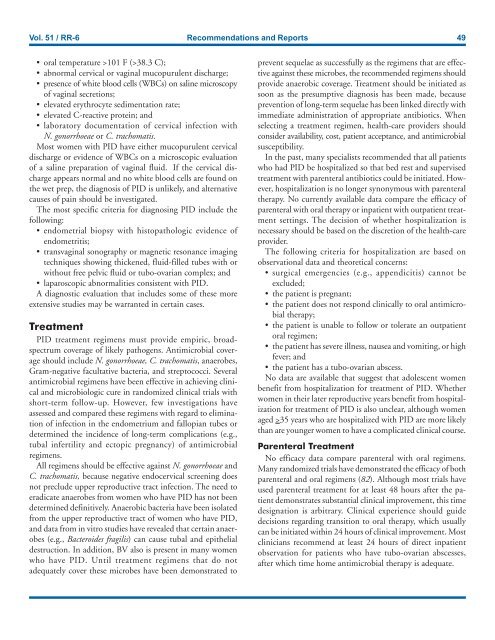Create successful ePaper yourself
Turn your PDF publications into a flip-book with our unique Google optimized e-Paper software.
Vol. 51 / RR-6 Recommendations and Reports 49<br />
oral temperature >101 F (>38.3 C);<br />
abnormal cervical or vaginal mucopurulent discharge;<br />
presence of white blood cells (WBCs) on saline microscopy<br />
of vaginal secretions;<br />
elevated erythrocyte sedimentation rate;<br />
elevated C-reactive protein; and<br />
laboratory documentation of cervical infection with<br />
N. gonorrhoeae or C. trachomatis.<br />
Most women with PID have either mucopurulent cervical<br />
discharge or evidence of WBCs on a microscopic evaluation<br />
of a saline preparation of vaginal fluid. If the cervical discharge<br />
appears normal and no white blood cells are found on<br />
the wet prep, the diagnosis of PID is u<strong>nl</strong>ikely, and alternative<br />
causes of pain should be investigated.<br />
The most specific criteria for diagnosing PID include the<br />
following:<br />
endometrial biopsy with histopathologic evidence of<br />
endometritis;<br />
transvaginal sonography or magnetic resonance imaging<br />
techniques showing thickened, fluid-filled tubes with or<br />
without free pelvic fluid or tubo-ovarian complex; and<br />
laparoscopic abnormalities consistent with PID.<br />
A diagnostic evaluation that includes some of these more<br />
extensive studies may be warranted in certain cases.<br />
Treatment<br />
PID treatment regimens must provide empiric, broadspectrum<br />
coverage of likely pathogens. Antimicrobial coverage<br />
should include N. gonorrhoeae, C. trachomatis, anaerobes,<br />
Gram-negative facultative bacteria, and streptococci. Several<br />
antimicrobial regimens have been effective in achieving clinical<br />
and microbiologic cure in randomized clinical trials with<br />
short-term follow-up. However, few investigations have<br />
assessed and compared these regimens with regard to elimination<br />
of infection in the endometrium and fallopian tubes or<br />
determined the incidence of long-term complications (e.g.,<br />
tubal infertility and ectopic pregnancy) of antimicrobial<br />
regimens.<br />
All regimens should be effective against N. gonorrhoeae and<br />
C. trachomatis, because negative endocervical screening does<br />
not preclude upper reproductive tract infection. The need to<br />
eradicate anaerobes from women who have PID has not been<br />
determined definitively. Anaerobic bacteria have been isolated<br />
from the upper reproductive tract of women who have PID,<br />
and data from in vitro studies have revealed that certain anaerobes<br />
(e.g., Bacteroides fragilis) can cause tubal and epithelial<br />
destruction. In addition, BV also is present in many women<br />
who have PID. Until treatment regimens that do not<br />
adequately cover these microbes have been demonstrated to<br />
prevent sequelae as successfully as the regimens that are effective<br />
against these microbes, the recommended regimens should<br />
provide anaerobic coverage. Treatment should be initiated as<br />
soon as the presumptive diagnosis has been made, because<br />
prevention of long-term sequelae has been linked directly with<br />
immediate administration of appropriate antibiotics. When<br />
selecting a treatment regimen, health-care providers should<br />
consider availability, cost, patient acceptance, and antimicrobial<br />
susceptibility.<br />
In the past, many specialists recommended that all patients<br />
who had PID be hospitalized so that bed rest and supervised<br />
treatment with parenteral antibiotics could be initiated. However,<br />
hospitalization is no longer synonymous with parenteral<br />
therapy. No currently available data compare the efficacy of<br />
parenteral with oral therapy or inpatient with outpatient treatment<br />
settings. The decision of whether hospitalization is<br />
necessary should be based on the discretion of the health-care<br />
provider.<br />
The following criteria for hospitalization are based on<br />
observational data and theoretical concerns:<br />
surgical emergencies (e.g., appendicitis) cannot be<br />
excluded;<br />
the patient is pregnant;<br />
the patient does not respond clinically to oral antimicrobial<br />
therapy;<br />
the patient is unable to follow or tolerate an outpatient<br />
oral regimen;<br />
the patient has severe illness, nausea and vomiting, or high<br />
fever; and<br />
the patient has a tubo-ovarian abscess.<br />
No data are available that suggest that adolescent women<br />
benefit from hospitalization for treatment of PID. Whether<br />
women in their later reproductive years benefit from hospitalization<br />
for treatment of PID is also unclear, although women<br />
aged >35 years who are hospitalized with PID are more likely<br />
than are younger women to have a complicated clinical course.<br />
Parenteral Treatment<br />
No efficacy data compare parenteral with oral regimens.<br />
Many randomized trials have demonstrated the efficacy of both<br />
parenteral and oral regimens (82). Although most trials have<br />
used parenteral treatment for at least 48 hours after the patient<br />
demonstrates substantial clinical improvement, this time<br />
designation is arbitrary. Clinical experience should guide<br />
decisions regarding transition to oral therapy, which usually<br />
can be initiated within 24 hours of clinical improvement. Most<br />
clinicians recommend at least 24 hours of direct inpatient<br />
observation for patients who have tubo-ovarian abscesses,<br />
after which time home antimicrobial therapy is adequate.


